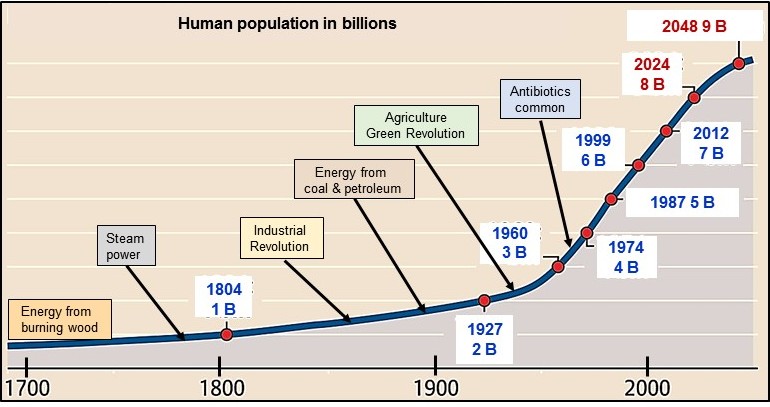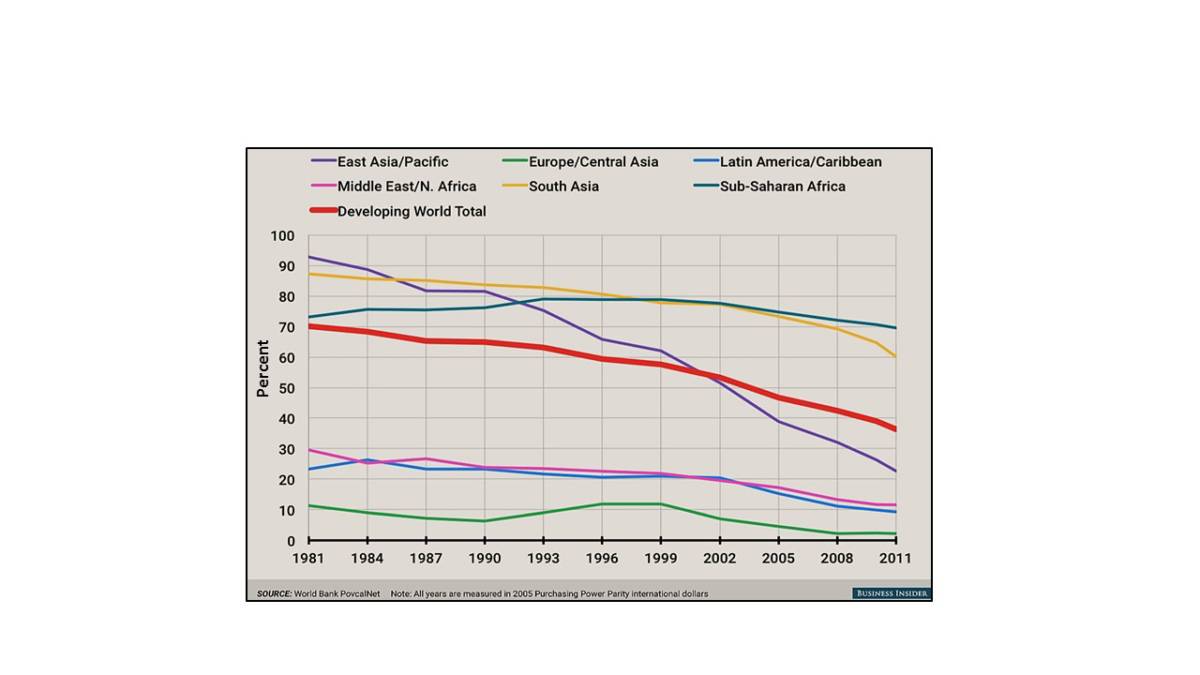 Human population growth: Is the explosion a blessing or a curse?
Human population growth: Is the explosion a blessing or a curse?
Probably the strongest biological urge for living organisms making up Earth’s biosphere is that of reproduction. Within the biological sciences, many consider that reproduction is, in fact, the primary purpose of life, and it has likely been that way since life first developed on Earth somewhere around four billion years ago. Paradoxically, although this urge is pretty much a requirement for the continued survival of any species, it also can generate serious overpopulation problems, up to and including the potential loss of an entire population. Our species, Homo sapiens, is also bound by the same biological urges. It is of more than just passing interest to consider our own population growth, which has been especially rapid since the early 1900s.
Are there really too many humans?
A very significant event has occurred on Earth within a time interval that represents less than the blink of an eye in the long history of the planet. That event is the evolution of modern humans (Homo sapiens sapiens) within the last 300,000 years and especially the recent explosive (possibly catastrophic) growth of global human population. Although precise figures are not available for early in human history, several human population growth curves have been published, some for just the past 100 years and some extrapolating back into the “stone age” of human development over 10,000 years ago.
Most evident from all published curves is that human population appears to have stayed at a relatively constant low level for most of our history but has almost literally exploded within the past 150 years. Although the one billion “body count” was not reached until around 1800, there are over seven billion humans currently (as of 2017) inhabiting Earth. Most population projections indicate that we will reach eight billion within the next 10–15 years and perhaps reach over nine billion by the middle of this 21st century. That is assuming, of course, that no catastrophic events occur such as an extraterrestrial bolide impact, a global pandemic that kills over 50 million people worldwide, a nuclear war, etc.

A variety of scientific and social science disciplines are directly or indirectly concerned with this possibly alarming rate of human population growth. Some of those fields of study include biology, sociology, religion, economics, and politics. Of historical note, a landmark but somewhat out-of-date book on this very subject was written by the biologists Dr. Paul Ehrlich and his wife Anne Ehrlich titled “The Population Bomb” (1968). Ehrlich predicted that explosive human population growth would result in a number of imminent catastrophic events beginning in the 1970s, including famine and mass starvation. I read the book as a graduate student and was very influenced by it, even though his predictions did not materialize in the time frame he predicted, in part because of the Green Revolution in agriculture. However, the underlying biological constraints and events he predicted are certainly still in play and need to be addressed. As we will discuss, if human population growth is not controlled by us, it will inevitably be controlled by “nature,” and perhaps in the not too distant future.
Humans, just like other species, require natural resources to survive and reproduce. However, just surviving does not sound like a comfortable way to live, although that is pretty much how we, for most of our 300,000-year history, and all other animals we share this planet with have survived. In the modern world, consider the enormous differences in “standards of living” among populations within various countries. For example, the United States represents a small fraction of global human population (about 5 percent), but we consume a very significant of all global resources for our standard of living (about 24 percent). In contrast, much of the world’s human populations in developing countries have not progressed much beyond the survival standards.
All modern human populations require at least minimal levels of resources, such as food, potable water, actual living space, some energy source or sources, and at least a basic infrastructure. Most all of these resources have limits on availability, and such limits may occur on a local, regional, or global scale. For examples, just how much potable water is available on Earth? How much food can we produce and distribute? How long will the Earth’s finite supply of fossil fuels last, and what will replace this source of energy? If population growth continues unchecked, any one, or all of these resources will become a limiting factor controlling global human population size. To these limiting factors, we can also add catastrophic possibilities mentioned above.
Considering just one critical natural resource yields the following information:
—2.1 billion people lack access to safely managed drinking water services (WHO/UNICEF 2017).
—4.5 billion people lack safely managed sanitation services (WHO/UNICEF 2017).
—340,000 children under five die every year from diarrheal diseases (WHO/UNICEF 2015).
—Water scarcity already affects four out of every 10 people (WHO).
—90 percent of all-natural disasters are water-related (UNISDR).
—80 percent of wastewater flows back into the ecosystem without being treated or reused (UNESCO, 2017).
—Agriculture accounts for 70 percent of global water withdrawal (FAO UN, 2016).
—Roughly 75 percent of all industrial water withdrawals are used for energy production (UNESCO, 2014).
Human population growth
What are the factors and conditions that have contributed to our explosive population growth? Several have been suggested, and each plays a part:
—Rapid decrease in the death rate relative to the birth rate, which is due to significant advances in hygiene, and medical care, beginning especially in the mid 1900s, with the advent of antibiotics and other medical treatments.
—High birth rates were necessary to maintain population size before the late 1800s because of high mortality rates in babies and young children and a relatively short average overall longevity. Now, however, this high rate is the major driving influence in population growth. This is especially true in developing countries.
—The Industrial Revolution and the Green Revolution, which increased the ability of humans to produce food and other products, courtesy of burgeoning use of fossil fuels and technological advances.
—Lack of public and political awareness of the potential problems associated with immense population growth, and the unwillingness of governments to instigate or promote even modest birth control devices or methods. This unwillingness is tied directly to economic, political, and religious beliefs of the vast majority of humans in most developed and developing countries. Religious doctrine is especially significant. One example is taken from the Christian Bible. Unfortunately, this ancient historical caveat is seriously out of date and grossly misleading in the modern world: “And God blessed them. And God said to them, ‘Be fruitful and multiply and fill the earth
and subdue it and have dominion over the fish of the sea and over the birds of the
heavens and over every living thing that moves on the earth’” (Genesis 1.28)
Based on such writings within the confined mindset of most religions, any form of birth control and/or abortion is considered a sin. Perhaps that was a worthwhile idea over most of human history as a survival requirement, when a high mortality rate for the young required significant numbers of offspring to maintain a population size. Currently, however, such a mindlessly strict adherence to a religious inspired doctrine is turning out to be a nightmare for Earth and its inhabitants. Actually, Earth will probably survive as it has over its long history, but the inhabitants (humans) maybe not so much.
Another angle to population size considerations comes from the big business sector. More children and adults mean more things sold and consumed, which means more income for businesses. The other side of this coin, however, is the rapid growth of technology. In the 20th century, automation was born. In the late 20th century, robots and computers were developed. In the 21st, they are becoming more widespread, complex, and efficient. Additionally, much progress has been made towards the development of artificially intelligent machines. These advances have eliminated an enormous number of jobs. There has not been any significant creation of enough new kinds of jobs to offset this loss, and many of those jobs which have been created are in low-paying service industries. But global population is exploding … so what are people going to do to find enough work and enough income to support themselves and their families?
A recent internet article — “Have Lots Of Children. It’s Good For The Planet” by David Harsanyi — provides an interesting point of view on population growth and is discussed below. In fact, it was this article that provided the motivation for writing my opinion here as a form of rebuttal.
This article contains much sarcasm. Based on much of his writing, I wonder where, or even if, the author received or absorbed any significant scientific education related to his topic. The author begins with the ideas that Dr. Paul Ehrlich was a fraud, environmentalists “…embrace repulsive ideas about human beings,” global warming isn’t such a big deal, and we can fix everything with technology and by letting people do what they want (his stated libertarian point of view). Overall, the author seems to consider the world and its population to be in the best condition ever and that it is getting better. So getting to his main point, he therefore suggests that people should be allowed to have as many children as they want.
As the author claims to be a libertarian, my understanding is that a basic tenet of libertarianism is allowing people to do mostly what they want in pretty much all aspects of their lives with minimal government interference or control (see reference). Sounds like a rather noble idea, but it doesn’t seem to work very well in practice. But first, I am appalled that the author brushes off ideas of population control as if there are no problems with overpopulation and that environmentalists and biologists are simply clueless. It’s such a typical anti-science remark, and in this day and age of high-level developing complex technology and discovery, it represents a misplaced regressive ideology. Does this author have an agenda (The Federalist is known as a conservative, right-wing publication), or is it simply a matter of personal ignorance about biology, ecology, and the nature of this planet? Perhaps the author is writing just for a paycheck.
Below is another direct quote from the same Federalist article, and it provides a very telling picture of how misguided the author is. For a claimed successful journalist, I have to wonder about this quote. Clearly, the author seems to confuse weather and climate, and the overall terminology is rather strange. I am amazed that people were talking about “ugly weather” (whatever that means) all the time. Finally, to provide an answer to the rhetorical question, “yes, things be getting worse.”
“Everything is headed in the wrong direction for environmental scaremongers. If we’re
already experiencing the negative force of climate change — which I’m told we are
every time we have ugly weather somewhere in the country — shouldn’t things be
getting worse? Well, the real trouble is always right over the horizon.”
I would think that if this author (or anyone else) were a rational human without some unstated agenda or vested interest, they would consider the growth of human population more carefully as follows. If those “environmental scaremongers” are wrong but we take significant precautions now, we will possibly suffer some economic setbacks for some time, but we will probably survive reasonably intact. On the other hand, if those “environmental scaremongers” are right, and we don’t take precautions now, we will suffer much greater and perhaps catastrophic setbacks in the future, including the possibility of a collapse of civilization. Yes, I know, I know, more scaremongering, but what if? I wonder if he has children?
To continue harping, below is the World Bank graph cited in his article, which the author claims illustrates how much better economic conditions are getting in the “developing world” because today fewer people are living on less than $2 per day compared with 35 years ago. I am trying to be impressed, but actually, I find this situation appalling. What about the cost of goods and services over the past 35 years in developing countries — you know, that thing called inflation? What about their recognition of the amazing amenities and other stuff available in developed countries? You know, things like consistently available electricity, plumbing, sewage, clean potable water, and so on. Are they allowed to think about acquiring such stuff? Most certainly, these items have increased in cost. It is likely that the people in these countries are living under worse, not better, conditions. Takes a lot of chutzpa to consider this graph a valid reason for promoting continued population growth. I’d consider offering the author up to $10 per day to move to any of these countries, but then I would be as sarcastic and mean sounding as he seems to be in much of his article. But really, on that ten-spot, Harsanyi could presumably live like a king, write all day long, and be happy. Although I wonder if there would be a continuous source of electricity to power his computer or available water to flush his toilet (if he even would have one).
Percent of population living on under $2 per day

Source: World Bank Population. Measured on 2005 purchasing power
 If no other global catastrophic event occurs in the near future, say within the next 50 years, it could be strongly argued that the potential biological catastrophe for humans will be self-generated by willfully ignoring a large body of evidence that indicates overpopulation is dangerous to lethal for populations. To blindly ignore scientific evidence as in Harsanyi’s opinion article in favor of political, economic, or religious beliefs is basically foolhardy. We consider ourselves to be an intelligent species. It is time that we use that wonderful gift to protect our future as best we can.
If no other global catastrophic event occurs in the near future, say within the next 50 years, it could be strongly argued that the potential biological catastrophe for humans will be self-generated by willfully ignoring a large body of evidence that indicates overpopulation is dangerous to lethal for populations. To blindly ignore scientific evidence as in Harsanyi’s opinion article in favor of political, economic, or religious beliefs is basically foolhardy. We consider ourselves to be an intelligent species. It is time that we use that wonderful gift to protect our future as best we can.
So is this what we really want to do as human beings on a global scale?
The viewpoints expressed above are those of the author and do not necessarily reflect those of The Independent.
Articles related to “Human population growth: Is the explosion a blessing or a curse?”
Majority of Utahns believe climate change happening, humans partly responsible
Letter to the Editor: Climate change denial in southern Utah
Letter to the Editor: Citizens’ Climate Lobby encourages ethical tragedy
How to submit an article, guest opinion piece, or letter to the editor to The Independent
Do you have something to say? Want your voice to be heard by thousands of readers? Send The Independent your letter to the editor or guest opinion piece. All submissions will be considered for publication by our editorial staff. If your letter or editorial is accepted, it will run on suindependent.com, and we’ll promote it through all of our social media channels. We may even decide to include it in our monthly print edition. Just follow our simple submission guidelines and make your voice heard:
—Submissions should be between 300 and 1,500 words.
—Submissions must be sent to editor@infowest.com as a .doc, .docx, .txt, or .rtf file.
—The subject line of the email containing your submission should read “Letter to the editor.”
—Attach your name to both the email and the document file (we don’t run anonymous letters).
—If you have a photo or image you’d like us to use and it’s in .jpg format, at least 1200 X 754 pixels large, and your intellectual property (you own the copyright), feel free to attach it as well, though we reserve the right to choose a different image.
—If you are on Twitter and would like a shout-out when your piece or letter is published, include that in your correspondence and we’ll give you a mention at the time of publication.



